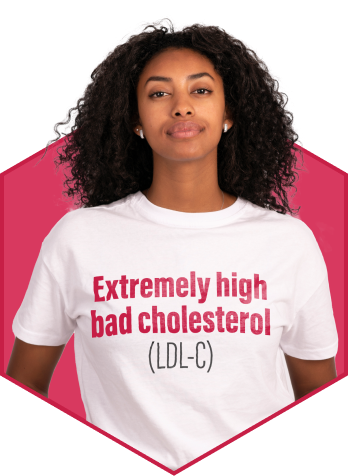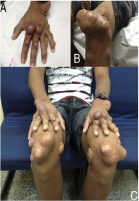If you have extremely high levels of bad cholesterol (LDL-C), you might have


What is HoFH?
HoFH is a serious, lifelong, ultra-rare disease that is inherited from your parents, and it means your body is unable to clear bad cholesterol (LDL-C). This can result in plaque deposits in your arteries, called atherosclerosis, and often leads to early heart attacks, strokes, and other diseases involving the arteries.
HoFH is typically managed with multiple treatment approaches, including lifestyle changes, medications and other therapies.
Having HoFH means you have extremely high levels of bad cholesterol (LDL-C), reaching or exceeding levels 5x higher than target (≥10 mmol/L with HoFH vs 1.8 mmol/L target for adults with cardiovascular risk).
HoFH affects around 1 in 300,000 people, many of whom are not diagnosed or are diagnosed later in life which delays critical treatment.
Prevalence is higher in these groups:
1 in 275,000 French Canadians
1 in 30,000 Afrikaners in South Africa
1 in 100,000 Christian Lebanese
How is HoFH different from HeFH?
HoFH and HeFH can look quite similar; in fact, a significant number of people are initially misdiagnosed, as HoFH can be often mistaken for HeFH.
| Homozygous FH (HoFH) | Heterozygous FH (HeFH) |
|---|---|
| Mutated genes inherited from both parents | Mutated gene inherited from one parent |
| Occurs in 1 in 300,000 persons | Occurs in 1 in 250 persons |
| LDL-C >10 mmol/L (untreated) |
LDL-C cholesterol ≥4.1 mmol/L in children LDL-C cholesterol ≥4.9 mmol/L in adults |
| Likely physical symptoms, such as cholesterol deposits in the eye, tendons, knees, elbows and/ or between fingers and toes; these deposits are not always present | May have physical symptoms, such as cholesterol deposits in the eye, tendons, knees, elbows and/or between fingers and toes |
| Treatment at time of diagnosis, no matter the age, with a specialist | Treatment as early as age 10 |
Adapted from McGowan and Cuchel et al.
Who gets it?
HoFH occurs when two mutated copies of FH-causing gene alleles are inherited, one from each parent; those parents most likely have the more common Heterozygous FH.
The correct identification of HoFH can affect entire families, as parents and other relatives may also be identified with FH. A person with HoFH may have siblings with HeFH.

What are the risks?
HoFH can progress quickly and have lifelong effects, leading to premature heart attacks, strokes and other cardiovascular events, often within the first two decades of life.
A missed diagnosis, misdiagnosis, or suboptimal treatment can allow the disease to progress.
At Birth
High levels of bad cholesterol (LDL-C)
Extremely high levels of bad cholesterol (LDL-C as high as 13 mmol/L in an unborn baby and 18 mmol/L in a newborn)
Many cases are not diagnosed in childhood, when the progression of the disease may still be preventable
During childhood
Deposits of cholesterol develop in skin, tendons, and blood vessels
Cholesterol accumulates in the valves, leading to heart issues
May experience a heart attack before the age of 10
Many patients with HoFH are not diagnosed until they suffer an event
During adolescence
First heart attack, stroke or other heart-related event
Cholesterol and calcium deposits continue to develop
Worsening build up of fibrous tissue and inflammation can lead to heart defects
Many people with HoFH are not correctly diagnosed until they become adults, which delays critical treatment of their LDL-C
Into adulthood
Plaque deposits in arteries and progressive disease of the arteries
Heart valve issues
Heart failure, sudden stoppage of the heart (cardiac arrest)
If untreated, people living with HoFH rarely survive beyond 30 years

Know the signs

Other members of your family who have Familial Hypercholesterolemia (this can be either HoFH or the more common HeFH)
Extremely high levels of bad cholesterol (LDL-C ≥10 mmol/L without treatment)
Early cardiovascular events, such as heart attack or stroke
Visible signs, such as fat build-up under the skin (called xanthomas), that can appear before the age of 10

Examples of xanthomas seen in children

Examples of xanthomas seen in adults
Next steps
Talk to your doctor about a diagnosis; with the right early diagnosis, you can take action to lower your bad cholesterol (LDL-C) with a treatment plan tailored to your condition
Seek immediate care for your condition from a specialist (like a cardiologist or endocrinologist)
Find a specialized lipid clinic near youFind out if other family members are at risk of HoFH